Reflexology is a holistic healing technique using pressure points on the feet to promote health and well-being. It enhances blood circulation, strengthens the immune system, and reduces stress, offering a natural approach to overall wellness.
1.1 Definition of Reflexology
Reflexology is a non-invasive, holistic therapy that involves applying manual pressure to specific points on the feet or hands. These points correspond to organs, glands, and systems within the body, based on the belief that areas on the feet mirror the body’s internal structures. By stimulating these reflex points, practitioners aim to restore balance, enhance energy flow, and promote overall well-being. Reflexology is not a medical treatment but a complementary therapy often used to alleviate stress, improve circulation, and support the body’s natural healing processes.
1.2 History and Origins of Reflexology
Reflexology has ancient roots, with evidence of its practice dating back to Egypt around 2500 BCE and China over 5,000 years ago. Egyptian tomb paintings depict foot treatments, while Chinese practices linked reflexology to acupuncture and energy flow. In the early 20th century, Eunice Ingham refined these concepts, creating detailed foot charts and establishing modern reflexology. Her work laid the foundation for today’s techniques, emphasizing the connection between foot reflex points and the body’s organs. Reflexology has since evolved globally, blending traditional methods with contemporary practices, making it a popular holistic therapy for promoting health and wellness.
1.3 Benefits of Using a Foot Reflexology Chart
A foot reflexology chart is a valuable tool for understanding the connection between foot reflex points and body organs. It helps identify specific areas to target for relief from pain, stress, and various health conditions. By using the chart, individuals can practice self-reflexology, empowering them to take control of their wellness. Professionals also benefit from its detailed guidance, enhancing their massage techniques. The chart’s visual representation makes it easier to locate pressure points, ensuring accurate and effective treatments. Regular use can lead to improved overall health, enhanced energy levels, and a deeper understanding of the body’s internal functions, promoting holistic well-being.
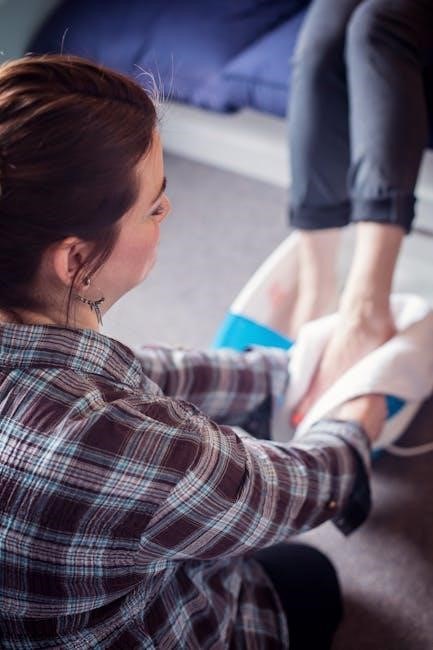
Understanding the Foot Reflexology Chart
A foot reflexology chart is divided into zones, explaining the connection between foot areas and body organs. It guides in locating pressure points for targeted wellness and enhances self-treatment routines.
2.1 Structure of the Foot Reflexology Chart
The foot reflexology chart is a detailed visual map illustrating the connection between foot zones and body organs. It is typically divided into vertical zones, with each area corresponding to specific organs or systems. Labels and color-coding help identify reflex points, making it easier to locate areas for targeted therapy. The chart often includes anatomical references, such as the solar plexus, liver, and stomach, mapped to specific foot regions. This structured design allows users to understand how pressure applied to certain areas can influence overall health. High-quality charts are available in formats like PDF and Illustrator for clarity and professional use.
2.2 Types of Foot Reflexology Charts
Foot reflexology charts are available in various types to suit different needs. The most common include the outside and inside charts, which detail pressure points on the foot’s outer and inner surfaces. Some charts focus on specific zones, such as the top or bottom of the foot, while others provide a full-body view. Color-coded charts enhance readability, and detailed anatomical charts are ideal for professionals. Printable formats like PDF and Illustrator ensure high-quality reproduction. Each type offers unique benefits, catering to both beginners and experienced practitioners, making reflexology accessible and effective for personal or therapeutic use.
2.3 Key Pressure Points on the Foot
Key pressure points on the foot are specific areas linked to organs and systems in the body. The big toe, for instance, corresponds to the head and sinuses, while the ball of the foot connects to the chest and lungs. The arch of the foot is associated with the liver, pancreas, and solar plexus. Pressure points on the heel relate to the lower back and intestines. These points, when stimulated, can relieve pain, improve organ function, and promote relaxation. The solar plexus point, located on the mid-arch, is particularly effective for digestion and stress relief. Techniques involve applying gentle to firm pressure using thumbs or fingers.
Zones and Reflex Areas on the Foot
The foot is divided into vertical zones, each corresponding to specific body organs. The left foot mirrors the left side of the body, while the right foot mirrors the right side. Reflex areas on the foot are strategically located to target organs like the brain, located in the big toe, and the solar plexus in the arch, aiding digestion and stress relief.
3.1 Division of the Foot into Vertical Zones
The foot is divided into ten equal vertical zones, with five on each foot. These zones correspond to specific areas of the body, from the head to the pelvis. The left foot mirrors the left side of the body, while the right foot mirrors the right side. Each zone is further divided into smaller reflex areas that target specific organs and systems. For example, the big toe represents the brain and pituitary gland, while the arch of the foot corresponds to the solar plexus and digestive organs. This systematic division allows for precise targeting of pressure points to promote overall health and balance.
3.2 Correspondence Between Foot Zones and Body Organs
Each vertical zone on the foot corresponds to specific organs and systems in the body. The left foot mirrors the left side of the body, while the right foot mirrors the right side. For instance, the big toe represents the brain and pituitary gland, while the ball of the foot corresponds to the chest and lungs. The arch of the foot is linked to the liver, pancreas, and solar plexus. This precise mapping allows reflexologists to target specific areas, enabling them to address a wide range of health concerns, from digestive issues to stress-related conditions, through focused pressure applications.
3.3 Location of Specific Reflex Points
Specific reflex points are strategically located on the foot to target corresponding body organs and systems. For example, the shoulder reflex point is found on the proximal side of the fifth metatarsal bone, while the elbow reflex is near the tuberosity of the same bone. These points are carefully mapped to ensure accurate stimulation. The solar plexus reflex, located on the arch of the foot, corresponds to the abdominal organs. Using a reflexology chart, individuals can pinpoint these areas with precision, enabling effective self-reflexology practices. Proper identification of these points is essential for maximizing therapeutic benefits and achieving overall well-being.
Practical Applications of the Foot Reflexology Chart
The foot reflexology chart offers practical applications for self-care and professional use, enabling precise location of reflex points, creation of massage routines, and promotion of therapeutic benefits.
4.1 How to Use the Chart for Self-Reflexology
To use the chart for self-reflexology, start by understanding the reflex points and their corresponding body organs. Locate the specific areas on your feet using the chart as a guide. Apply gentle pressure with your fingers or a tool, focusing on sore spots. Massage each point in circular motions for 5-10 minutes. Create a routine by targeting different areas daily to enhance overall well-being. Regular practice can improve circulation, reduce stress, and boost energy. For best results, use the chart consistently and adjust pressure based on comfort. This self-care practice empowers you to take charge of your health naturally.
4.2 Techniques for Applying Pressure on Reflex Points
Applying pressure on reflex points involves using your fingers or tools to stimulate specific areas. Start with gentle pressure, gradually increasing as needed. Use circular motions or thumb walking techniques to target points effectively. Focus on sore spots, massaging for 5-10 seconds each. For deeper pressure, use the knuckles or a reflexology stick. Always work in the direction of energy flow, typically from the heel toward the toes. Avoid applying too much pressure, as it may cause discomfort. Breathe deeply to relax and enhance the benefits. Regular practice improves circulation, reduces tension, and promotes overall well-being through targeted stimulation of reflex areas.
4.3 Tips for Creating a Massage Routine
Start by creating a calm and comfortable environment. Use a foot reflexology chart to identify key points and plan your routine. Begin with gentle pressure, gradually increasing intensity. Incorporate techniques like thumb walking or circular motions to stimulate reflex areas. Focus on areas corresponding to your health concerns, such as the solar plexus for stress relief. End with soothing strokes to relax the feet. Customize your routine based on your needs, ensuring consistency for optimal benefits. Regular practice enhances circulation, reduces tension, and promotes overall well-being. Make it a habit to massage at the same time daily for best results.
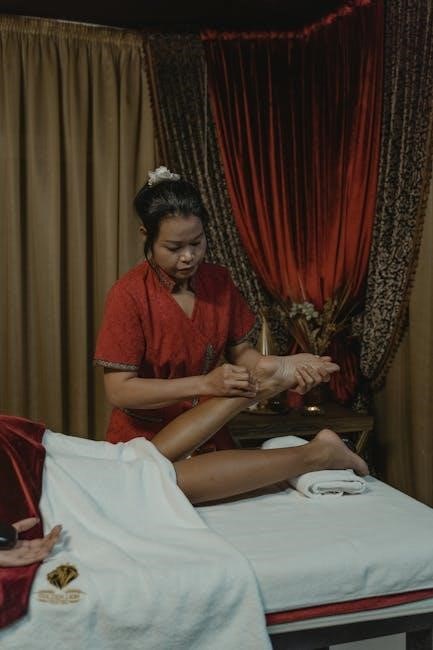
Health Benefits of Foot Reflexology
Foot reflexology improves blood circulation, strengthens the immune system, reduces stress and anxiety, boosts energy levels, and enhances overall well-being through targeted pressure point stimulation.
5.1 Improvement in Blood Circulation
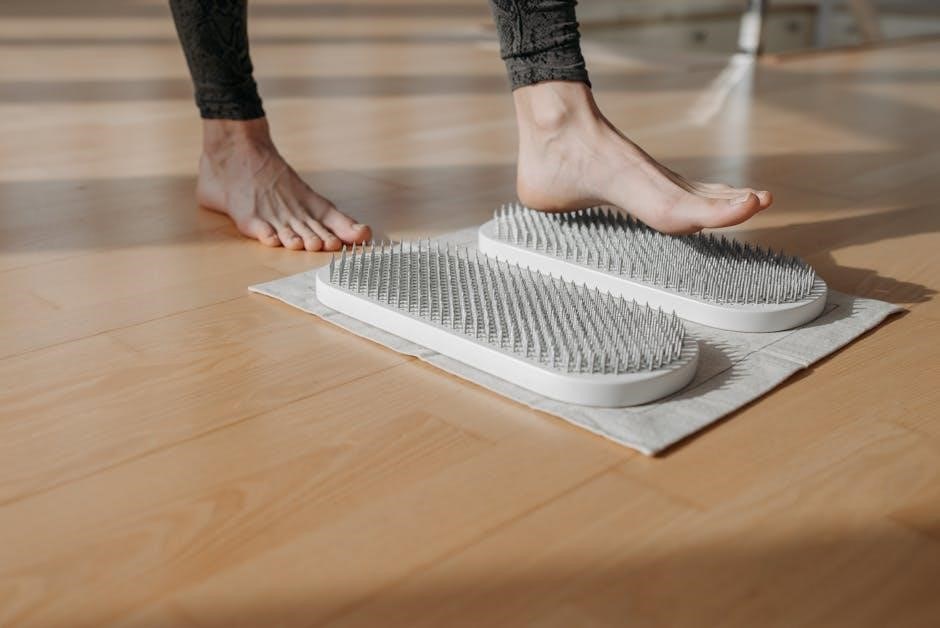
Foot reflexology enhances blood circulation by stimulating specific pressure points on the feet, which promotes healthy blood flow throughout the body. Improved circulation allows oxygen and nutrients to reach cells more efficiently, supporting overall well-being. Regular reflexology sessions can help alleviate conditions like cold hands and feet by boosting vascular function. The gentle pressure applied to reflex points also relaxes blood vessels, reducing tension and improving cardiovascular health. This natural therapy not only benefits physical health but also contributes to emotional relaxation, making it a holistic approach to maintaining a balanced and healthy lifestyle. Regular practice can lead to long-term circulatory benefits.
5.2 Enhanced Immune System Function
Foot reflexology supports immune system function by targeting specific reflex points that correspond to organs like the spleen and lymph nodes. Stimulating these areas helps boost the body’s natural defense mechanisms, promoting the removal of toxins and pathogens. Regular reflexology sessions can enhance lymphatic drainage, reducing inflammation and improving overall immune response. By activating these points, reflexology aids in balancing the body’s energy, which is crucial for maintaining strong immunity. This holistic approach not only strengthens the immune system but also contributes to overall well-being, making it a popular complementary therapy for preventing illnesses and supporting long-term health.
5.3 Reduction of Stress and Anxiety
Foot reflexology is highly effective in reducing stress and anxiety by targeting specific pressure points that calm the nervous system. The solar plexus and adrenal gland reflex points, located on the ball of the foot, help alleviate tension and promote relaxation. By stimulating these areas, reflexology can lower cortisol levels, the body’s stress hormone, and induce a deep sense of calm. Regular sessions can also improve sleep quality and emotional well-being, offering a natural solution to manage stress and anxiety. This therapy provides a holistic approach to mental health, helping individuals achieve balance and serenity in their daily lives.
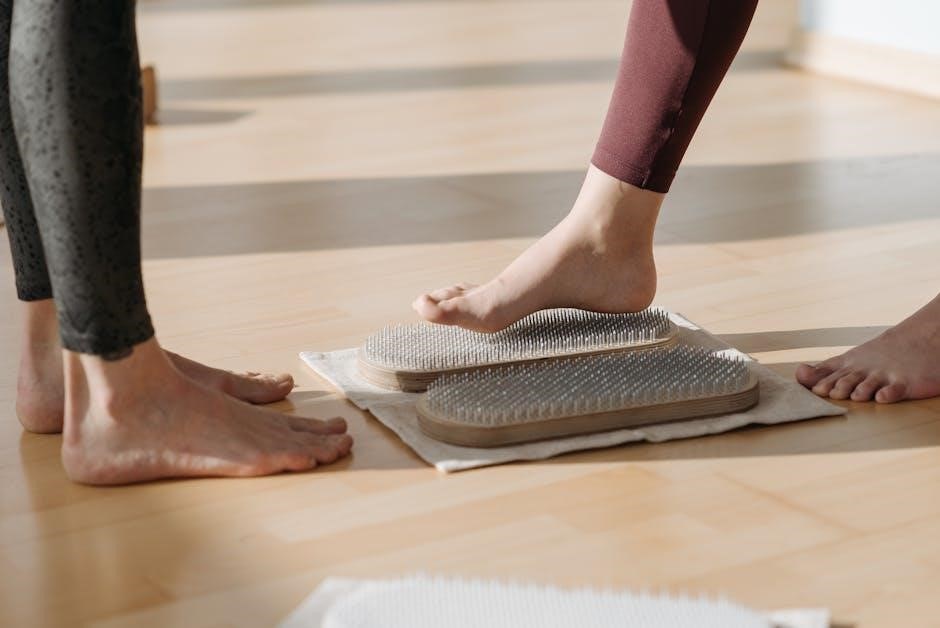
How to Download and Print a Foot Reflexology Chart
Download high-quality foot reflexology charts in PDF or Illustrator formats from reputable sources like Feet First or Laura Norman Reflexology for personal or professional use.
6.1 Sources for Free Reflexology Charts
Free reflexology charts are available from reputable sources like Feet First and Laura Norman Reflexology. These charts are downloadable in PDF and Illustrator formats, offering high-quality visuals for personal or professional use. Websites like Foot Reflexology Chart and Reflexology Maps provide detailed, printable charts that outline pressure points and their corresponding body organs. Additionally, online platforms such as Adobe Stock and free PDF repositories offer a wide range of reflexology charts suitable for both beginners and practitioners. These resources ensure easy access to accurate and visually appealing charts for effective reflexology practice.
6.2 Steps to Print a High-Quality Chart
To print a high-quality reflexology chart, start by downloading a PDF or Illustrator file from a trusted source. Ensure your printer is set to high-resolution settings for crisp details. Use durable, glossy paper to enhance clarity and color accuracy. Adjust the chart’s size and orientation to fit standard paper dimensions. For best results, print in full color to maintain the visual guides and labels. Consider laminating the chart for long-term use. Properly align the print area to avoid cropping essential details. Finally, review the printed chart for readability and accuracy before using it for reflexology practice.
6.3 Recommended Formats (PDF, Illustrator)
Reflexology charts are commonly available in PDF and Illustrator formats, ensuring high-quality visuals and scalability. PDF files are ideal for printing and sharing, as they maintain resolution and clarity across devices. Illustrator files are preferred for professionals needing to edit or customize charts, offering layered and vector-based designs for precision. Both formats provide detailed mappings of reflex points, making them essential for accurate practice. PDFs are universally accessible, while Illustrator files cater to advanced users. Downloading charts in these formats ensures you have a clear, professional-grade tool for foot reflexology applications.
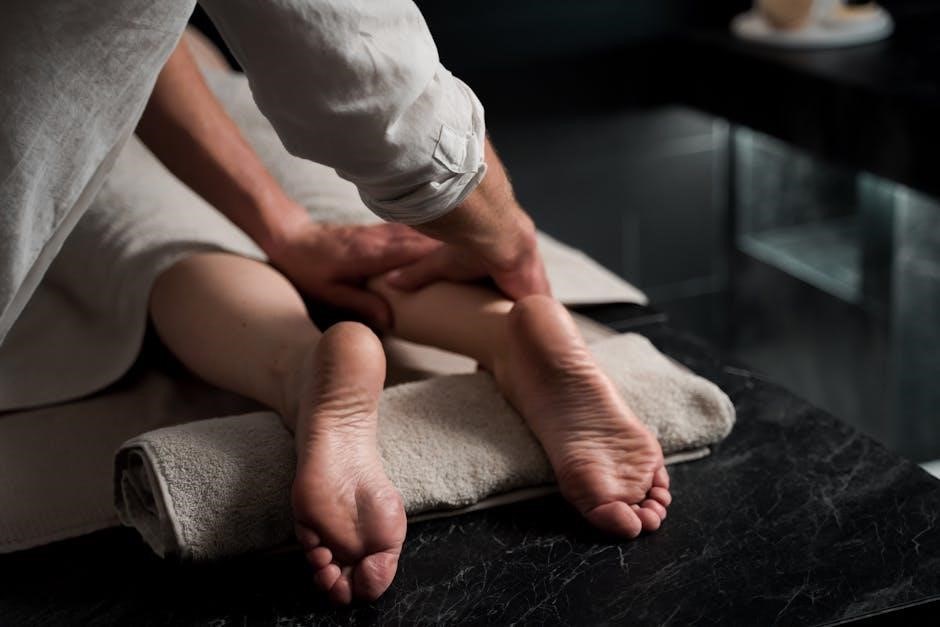
Advanced Techniques and Therapies
Advanced reflexology techniques combine pressure point therapy with energy healing and palliative care, enhancing emotional and physical well-being through tailored, holistic approaches for diverse health needs.
7.1 Combining Reflexology with Other Therapies
Combining reflexology with therapies like acupuncture, massage, or energy healing enhances its holistic benefits. This integrative approach addresses both physical and emotional well-being, amplifying relaxation and pain relief. Reflexology complements practices like yoga and tai chi by improving energy flow and balance. Additionally, its use in palliative care alongside aromatherapy and mindfulness fosters comfort and emotional support for patients. The synergy of these therapies creates a comprehensive treatment plan, tailored to individual needs. This blend of modalities underscores reflexology’s versatility and its potential to deepen therapeutic outcomes when integrated with other healing practices.
7.2 Use of Reflexology in Palliative Care
Reflexology is increasingly used in palliative care to provide comfort and improve quality of life for patients with serious illnesses. By targeting specific pressure points on the feet, it helps reduce pain, alleviate symptoms, and promote relaxation. This therapy is particularly beneficial for individuals who may not respond well to conventional treatments. Reflexology also offers emotional and spiritual support, fostering a sense of calm and well-being. When combined with other therapies like aromatherapy or massage, it creates a holistic approach to care. Its non-invasive nature makes it an ideal option for patients seeking gentle, comforting interventions during their palliative journey.
7.3 Role of Reflexology in Energy Healing
Reflexology plays a significant role in energy healing by restoring balance to the body’s energy flow. It works on the principle that energy pathways, or “meridians,” can be accessed through specific reflex points on the feet. By applying pressure to these points, reflexology helps unblock stagnant energy, promoting the free flow of “Qi” and enhancing overall vitality. This practice is often combined with other energy-based therapies to create a holistic approach to healing. Reflexology not only addresses physical discomfort but also aligns the body’s energy, leading to emotional harmony and spiritual well-being. It is a powerful tool for those seeking energetic balance and renewal.
Scientific Evidence and Research
Research on reflexology shows mixed results, with studies indicating its potential to improve circulation and reduce pain. However, more rigorous trials are needed to confirm its efficacy.
8.1 Studies on the Effectiveness of Reflexology
Studies on reflexology have shown its potential to improve blood circulation, enhance immune function, and reduce stress. Some research indicates positive outcomes for pain relief and relaxation. However, scientific evidence remains limited, with few large-scale, rigorous trials. Many studies highlight anecdotal benefits, as both practitioners and patients report improved well-being. Despite this, reflexology is not universally accepted as a medical treatment due to the lack of conclusive evidence. Further research is needed to establish its efficacy and understand its mechanisms fully; Reflexology charts, like the foot reflexology PDF, guide practitioners but should be used alongside other therapies for comprehensive care.
8.2 Limitations of Reflexology as a Treatment
Reflexology is not recognized as a standalone medical treatment and lacks robust scientific evidence to support its efficacy for diagnosing or curing diseases. While it may enhance relaxation and well-being, results vary among individuals, and its benefits are largely anecdotal. Reflexology does not address severe medical conditions and should not replace conventional therapies. Additionally, there is no standardized training or regulation for practitioners, which can lead to inconsistent outcomes. The technique is best viewed as a complementary therapy to support overall health rather than a primary treatment for serious illnesses.
8.3 Case Studies and Patient Experiences
Case studies highlight the positive effects of reflexology, with many patients reporting reduced pain, improved mood, and enhanced relaxation. For instance, a 2018 study by S. Moore explored the use of VR foot reflexology, showing participants felt calm and relaxed. Similarly, a 2023 study by L. Mitchinson found reflexology helped women with chronic conditions manage symptoms and improve their quality of life. Patients often describe feeling deeply relaxed during sessions, with some experiencing long-term benefits like better sleep and reduced stress. These anecdotes demonstrate the potential of reflexology to complement traditional therapies and improve overall well-being.
Reflexology continues to evolve, integrating technology like VR and apps for enhanced practices. Its holistic approach and growing popularity highlight its potential as a complementary therapy for modern wellness.
9.1 Evolution of Reflexology Practices
Reflexology has evolved significantly from its ancient roots in Egypt and China. Modern practices now incorporate detailed foot reflexology charts, making it more accessible. The development of standardized zones and pressure points has enhanced its effectiveness. Advances in technology, such as VR and mobile apps, are transforming how reflexology is practiced. These innovations allow individuals to explore self-reflexology at home, expanding its reach. Additionally, the integration of reflexology with other therapies, like energy healing, highlights its adaptability. As research grows, reflexology continues to gain recognition, offering a holistic approach to wellness that blends traditional techniques with contemporary innovations for better health outcomes.
9.2 Integration of Technology in Reflexology
Technology has revolutionized reflexology by introducing innovative tools like virtual reality (VR) therapy sessions and mobile apps. These platforms provide interactive foot reflexology charts, guiding users to specific pressure points. Digital charts with 3D models offer precise visuals, enhancing understanding. Wearable devices now track reflexology sessions, offering personalized feedback. Additionally, online courses and virtual consultations enable global access to reflexology expertise. This integration of technology makes reflexology more accessible, allowing individuals to practice self-care effectively. It also supports professionals in delivering precise treatments, ensuring a modern, efficient approach to this ancient therapy.
9.3 Growing Popularity of Foot Reflexology
Foot reflexology is gaining widespread acceptance as a natural therapy for overall wellness. Its popularity stems from its accessibility and the ease of using foot reflexology charts to guide self-care routines. The ability to improve circulation, reduce stress, and boost immunity resonates with many seeking holistic health solutions. Additionally, the availability of free downloadable charts and digital tools has made reflexology more mainstream. People appreciate its non-invasive nature and the immediate relaxation it provides. As awareness grows, foot reflexology is becoming a preferred choice for those looking to enhance their health without relying on medication, contributing to its global appeal and acceptance.